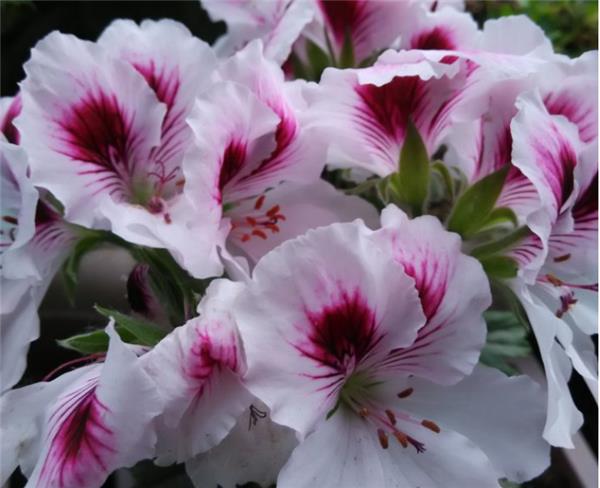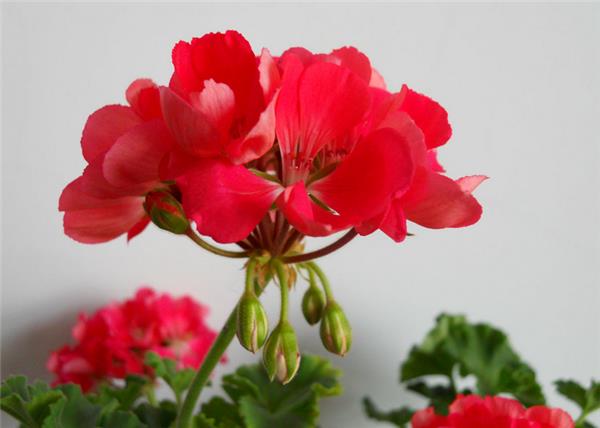What is the geranium language?
Geranium, which was first grown in South Africa, is an upright herbaceous flower with a fishy smell. Now many varieties have been cultivated. Let's share with you the knowledge of geranium language.

What is the geranium language?
Geranium language: accidental encounter, happiness is by your side.
Red geranium: I can't get you out of my mind.
Pink geranium: I'm glad to be with you.
Yellow geranium: unexpected encounter.
Silver leaf pelargonium: recall.

Dark geranium: depressed.
Trailing geraniums: wedding gifts.
Spice with geraniums: looking forward to meeting.
Wild geranium: pious and determined.
Variegated geranium: sincere friendship.

Different colors of geraniums represent different flower words, but several of them mean happiness.
Geranium, alias hydrangea, stone red, into wax red, sunflower, sunflower, originally from South Africa, is a perennial herbaceous flower. The leaf has a long handle, the leaf margin is serrated, and the leaf surface has deep annular markings. Corolla usually 5-merous, inflorescences umbellate, growing at tip of straight pedicel. Because the flowers are as dense as balls, it is also known as hydrangea. The colors of red, white, pink and purple vary a lot. The florescence begins in early winter and lasts until the beginning of summer. Can be potted indoors and outdoors; can be used as flowers in spring flower beds.
It is 30m high and 60m high. Stem erect, base Lignified, distal fleshy, much branched or unbranched, with conspicuous nodes, densely pubescent, strongly fishy leaves alternate; stipules broadly triangular or ovate, 815 mm long, pilose and glandular hairy; petiole 3 Mel 10 m long, finely pilose and glandular hairy Leaf blade orbicular or reniform, stem heart-shaped, 3m in diameter, margin undulate-lobed, with rounded teeth, transparent pubescent on both sides, dark red horseshoe-shaped ring within leaf margin.

Umbels axillary, many flowered, peduncles longer than leaves, pubescent; involucral bracts several, broadly ovate; pedicels 3 Mel 4 cm, pilose and glandular hairy. Buds pendulous, anthesis erect; sepals narrowly lanceolate, 8 mm long, densely glandular hairy and villous outside, petals red, orange, pink or white, broadly Obovate, 12-15 mm long, 6-color 8 mm wide, apex rounded, base shortly clawed, lower 3 usually larger; ovary densely pubescent. Capsule ca. 3 cm, pilose. Flowering from May to July and fruiting from June to September. In addition to summer dormancy, if the environment is suitable, it can continue to bloom. Like cold, but also not resistant to cold. Avoid high temperature, like sufficient sunshine, like fertile loam with good drainage; not resistant to water and humidity, too much humidity is easy to grow, slightly resistant to drought. The suitable temperature for growth is about 15 ℃ in the daytime and no less than 5 ℃ at night. Summer dormancy or semi-dormancy, should be placed in a semi-shady place, and control moisture.
Common varieties are true love, single flower, red. Fantasia, large flower, semidouble, red. Chewing gum, bicolor, crimson flowers, pink heart. Purple ball 2 Peibal, semidouble, fuchsia. Tango purple, large flower species, pure purple flowers. Merlot, large, semidouble, bright red. Jana, large flowers, bicolor species, flowers deep pink, heart magenta. Samgba, large flower species, crimson flowers. Arava, semidouble, light orange red. Grape designer, semidouble fuchsia, white eye. Lost white, pure white flowers.
Related
- Wuhan Hospital Iron Tree Blooming Result Was Instantly Frightened by the Gardener Master
- Which variety of camellia is the most fragrant and best? Which one do you like best?
- What is the small blue coat, the breeding methods and matters needing attention of the succulent plant
- Dormancy time and maintenance management of succulent plants during dormancy
- Minas succulent how to raise, Minas succulent plant pictures
- What are the varieties of winter succulent plants
- How to raise succulent plants in twelve rolls? let's take a look at some experience of breeding twelve rolls.
- Attention should be paid to water control for succulent plants during dormant period (winter and summer)
- Watering experience of twelve rolls of succulent plants
- Techniques for fertilizing succulent plants. An article will let you know how to fertilize succulent plants.



